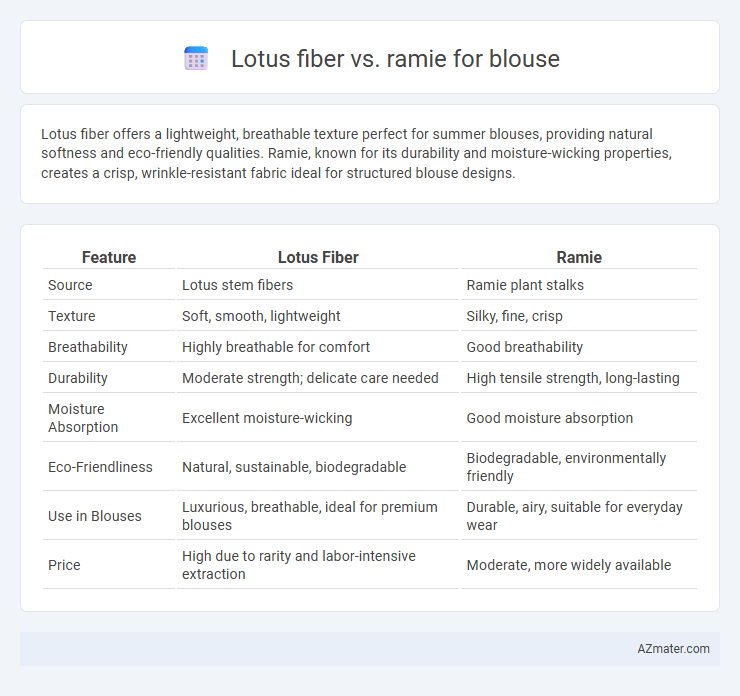Lotus fiber offers a lightweight, breathable texture perfect for summer blouses, providing natural softness and eco-friendly qualities. Ramie, known for its durability and moisture-wicking properties, creates a crisp, wrinkle-resistant fabric ideal for structured blouse designs.
Table of Comparison
| Feature | Lotus Fiber | Ramie |
|---|---|---|
| Source | Lotus stem fibers | Ramie plant stalks |
| Texture | Soft, smooth, lightweight | Silky, fine, crisp |
| Breathability | Highly breathable for comfort | Good breathability |
| Durability | Moderate strength; delicate care needed | High tensile strength, long-lasting |
| Moisture Absorption | Excellent moisture-wicking | Good moisture absorption |
| Eco-Friendliness | Natural, sustainable, biodegradable | Biodegradable, environmentally friendly |
| Use in Blouses | Luxurious, breathable, ideal for premium blouses | Durable, airy, suitable for everyday wear |
| Price | High due to rarity and labor-intensive extraction | Moderate, more widely available |
Introduction: Comparing Lotus Fiber and Ramie for Blouse Fabrics
Lotus fiber and ramie both offer sustainable and breathable textile options for blouse fabrics, but they differ significantly in texture and durability. Lotus fiber, derived from lotus stems, is lightweight, soft, and possesses a unique natural sheen, making it ideal for luxurious and delicate blouses. Ramie, extracted from the stalks of the ramie plant, is stronger and more resilient, offering a crisp feel and excellent moisture-wicking properties suitable for everyday wear.
Origin and Production Methods of Lotus Fiber
Lotus fiber, derived from the stems of the lotus plant predominantly found in Myanmar, Vietnam, and Thailand, is extracted through a meticulous hand-harvesting and filament-retrieval process that separates fine fibers without chemical treatment. Ramie, native to East Asia and primarily cultivated in China, undergoes a degumming process to remove gummy substances from the stalk fibers, enhancing softness and lustrous texture. The artisanal production of lotus fiber results in a rare, eco-friendly fabric prized for its breathability and natural sheen, while ramie offers durability and a silk-like appearance due to its biochemical processing.
Origin and Production Methods of Ramie
Ramie, a natural fiber derived from the stalks of the Chinese nettle plant, originates primarily in China, Brazil, and the Philippines, where traditional hand-picking and retting processes extract the fibrous material. The production method involves harvesting ramie stems, followed by degumming to remove gums and waxes, resulting in a fine, lustrous fiber ideal for lightweight blouses. Compared to lotus fiber, ramie's manufacturing emphasizes sustainable, water-based retting and mechanical processing that enhance its strength and sheen for delicate garment applications.
Eco-Friendliness: Lotus Fiber vs Ramie
Lotus fiber, derived from the lotus plant's stem, is highly eco-friendly due to its natural biodegradability and minimal water usage during cultivation, making it a sustainable choice for blouse fabric. Ramie, a bast fiber from the ramie plant, also boasts eco-friendly properties with rapid growth and low pesticide requirements but involves chemical retting processes that may impact its environmental footprint. Comparing both, lotus fiber offers superior environmental benefits with less processing impact, ideal for eco-conscious blouse production.
Texture and Comfort: How Lotus and Ramie Feel on Skin
Lotus fiber offers a smooth, silky texture with a natural sheen, providing a soft and breathable feel that enhances comfort for blouses. Ramie has a crisp, linen-like texture, slightly stiffer but becomes softer with washing, offering good moisture-wicking properties ideal for warm weather. Both fibers are hypoallergenic and eco-friendly, but lotus fiber is often preferred for its luxurious softness directly against the skin.
Durability and Longevity of Lotus Fiber vs Ramie
Lotus fiber exhibits superior durability and longevity compared to ramie, owing to its natural tensile strength and resistance to wear. Ramie, while strong, tends to be more prone to brittleness and deterioration over time when exposed to frequent washing and sunlight. Lotus fiber's resilience makes it an excellent choice for blouses requiring extended use with minimal fabric degradation.
Breathability and Moisture-Wicking Capabilities
Lotus fiber offers exceptional breathability due to its natural hollow structure, allowing air to circulate freely and keeping the wearer cool in hot climates. Ramie, while also breathable, has a denser fiber composition that provides moderate moisture-wicking abilities but tends to retain more moisture than lotus fiber. For blouses, lotus fiber excels in moisture management and ventilation, making it ideal for hot, humid conditions where comfort and dryness are priorities.
Dyeing and Color Retention: Lotus vs Ramie Blouses
Lotus fiber exhibits superior dye absorption and color retention compared to ramie, resulting in richer and longer-lasting hues in lotus blouses. Ramie, while vibrant initially, tends to fade faster due to its lower affinity for synthetic and natural dyes. Choosing lotus fiber for blouses ensures enhanced colorfastness and durability in varied washing conditions.
Cost Analysis: Affordability and Availability
Lotus fiber tends to be more expensive than ramie due to its labor-intensive extraction process and limited availability, often sourced from specific regions in Southeast Asia. Ramie is cost-effective because it is widely cultivated and has a faster harvest cycle, making it more accessible for blouse production. The affordability of ramie combined with its consistent supply makes it a preferred choice for manufacturers aiming to balance quality and production costs.
Final Verdict: Which is Better for Blouses – Lotus Fiber or Ramie?
Lotus fiber offers exceptional breathability and a unique, silky texture ideal for lightweight, luxurious blouses, while ramie provides superior durability and moisture-wicking properties suitable for everyday wear. The final verdict depends on the desired use: choose lotus fiber for premium, eco-friendly blouses with a soft hand feel, and ramie for sturdy, wrinkle-resistant garments with excellent moisture management. Both fibers are sustainable options, but lotus fiber excels in luxury and comfort, whereas ramie is favored for practicality and longevity.

Infographic: Lotus fiber vs Ramie for Blouse
 azmater.com
azmater.com